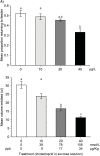Imidacloprid alters foraging and decreases bee avoidance of predators
- PMID: 25025334
- PMCID: PMC4099376
- DOI: 10.1371/journal.pone.0102725
Imidacloprid alters foraging and decreases bee avoidance of predators
Abstract
Concern is growing over the effects of neonicotinoid pesticides, which can impair honey bee cognition. We provide the first demonstration that sublethal concentrations of imidacloprid can harm honey bee decision-making about danger by significantly increasing the probability of a bee visiting a dangerous food source. Apis cerana is a native bee that is an important pollinator of agricultural crops and native plants in Asia. When foraging on nectar containing 40 µg/L (34 ppb) imidacloprid, honey bees (Apis cerana) showed no aversion to a feeder with a hornet predator, and 1.8 fold more bees chose the dangerous feeder as compared to control bees. Control bees exhibited significant predator avoidance. We also give the first evidence that foraging by A. cerana workers can be inhibited by sublethal concentrations of the pesticide, imidacloprid, which is widely used in Asia. Compared to bees collecting uncontaminated nectar, 23% fewer foragers returned to collect the nectar with 40 µg/L imidacloprid. Bees that did return respectively collected 46% and 63% less nectar containing 20 µg/L and 40 µg/L imidacloprid. These results suggest that the effects of neonicotinoids on honey bee decision-making and other advanced cognitive functions should be explored. Moreover, research should extend beyond the classic model, the European honey bee (A. mellifera), to other important bee species.
Conflict of interest statement
Figures



Similar articles
-
Abnormal foraging behavior induced by sublethal dosage of imidacloprid in the honey bee (Hymenoptera: Apidae).J Econ Entomol. 2008 Dec;101(6):1743-8. doi: 10.1603/0022-0493-101.6.1743. J Econ Entomol. 2008. PMID: 19133451
-
The neonicotinoid imidacloprid impairs honey bee aversive learning of simulated predation.J Exp Biol. 2015 Oct;218(Pt 20):3199-205. doi: 10.1242/jeb.127472. Epub 2015 Sep 7. J Exp Biol. 2015. PMID: 26347552
-
Sublethal imidacloprid effects on honey bee flower choices when foraging.Ecotoxicology. 2015 Nov;24(9):2017-25. doi: 10.1007/s10646-015-1537-2. Epub 2015 Sep 28. Ecotoxicology. 2015. PMID: 26415950
-
Review of field and monitoring studies investigating the role of nitro-substituted neonicotinoid insecticides in the reported losses of honey bee colonies (Apis mellifera).Ecotoxicology. 2016 Nov;25(9):1617-1629. doi: 10.1007/s10646-016-1734-7. Epub 2016 Oct 5. Ecotoxicology. 2016. PMID: 27709399 Free PMC article. Review.
-
Neonicotinoids in bees: a review on concentrations, side-effects and risk assessment.Ecotoxicology. 2012 May;21(4):973-92. doi: 10.1007/s10646-012-0863-x. Epub 2012 Feb 18. Ecotoxicology. 2012. PMID: 22350105 Free PMC article. Review.
Cited by
-
Increased survival of honeybees in the laboratory after simultaneous exposure to low doses of pesticides and bacteria.PLoS One. 2018 Jan 31;13(1):e0191256. doi: 10.1371/journal.pone.0191256. eCollection 2018. PLoS One. 2018. PMID: 29385177 Free PMC article.
-
A neonicotinoid impairs olfactory learning in Asian honey bees (Apis cerana) exposed as larvae or as adults.Sci Rep. 2015 Jun 18;5:10989. doi: 10.1038/srep10989. Sci Rep. 2015. PMID: 26086769 Free PMC article.
-
Weight of evidence evaluation of a network of adverse outcome pathways linking activation of the nicotinic acetylcholine receptor in honey bees to colony death.Sci Total Environ. 2017 Apr 15;584-585:751-775. doi: 10.1016/j.scitotenv.2017.01.113. Epub 2017 Jan 24. Sci Total Environ. 2017. PMID: 28126277 Free PMC article. Review.
-
Olfactory Learning Behavior and Mortality of the Honey Bee Apis mellifera jemenitica in Response to Pyrethroid Insecticide (Deltamethrin).Toxics. 2023 Dec 28;12(1):25. doi: 10.3390/toxics12010025. Toxics. 2023. PMID: 38250981 Free PMC article.
-
Thymol Affects Congruency Between Olfactory and Gustatory Stimuli in Bees.Sci Rep. 2019 May 23;9(1):7752. doi: 10.1038/s41598-019-43614-8. Sci Rep. 2019. PMID: 31123276 Free PMC article.
References
-
- Lonsdorf E, Ricketts T, Kremen C, Winfree R, Greenleaf S, et al. (2011) Crop pollination services. In: Karieva P, Tallis H, Ricketts T, Daily GC, Polasky S, editors. Natural capital: theory and practice of mapping ecosystem services. Oxford: Oxford University Press. 168–187.
Publication types
MeSH terms
Substances
LinkOut - more resources
Full Text Sources
Other Literature Sources

